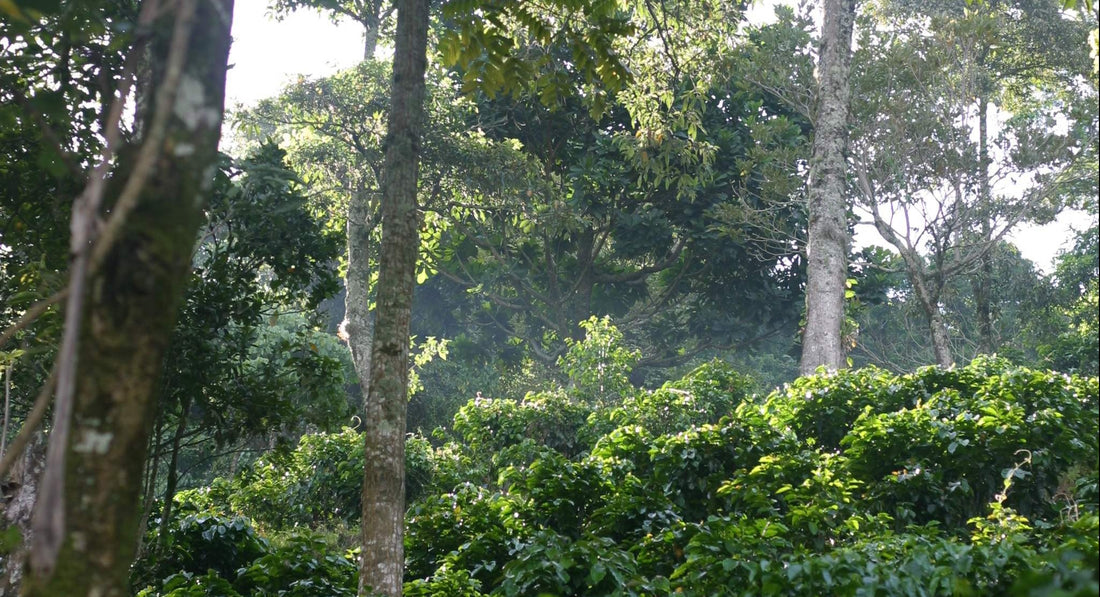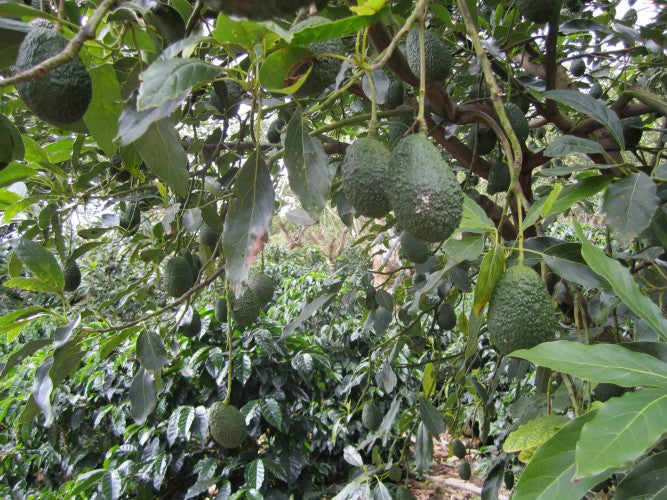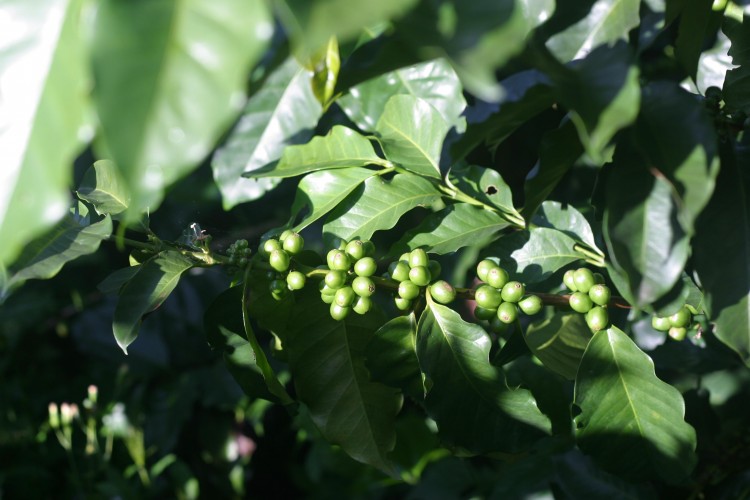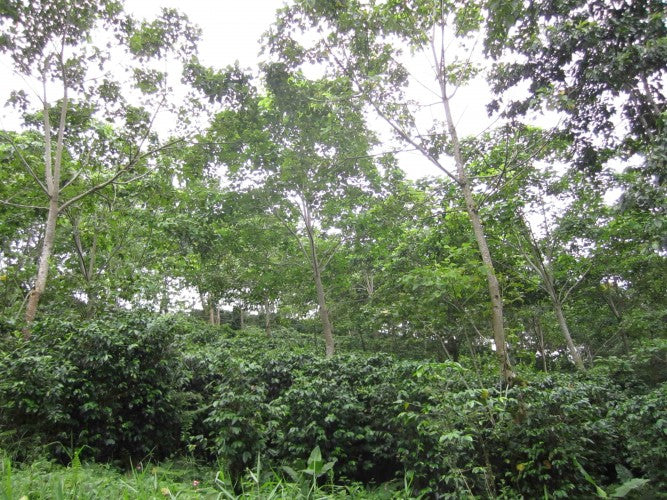
Shade Grown Coffee: What it means for you, the farmers, and the crop
Share
Coffee grows on trees, but it can also grow underneath and around them. Coffee is sometimes labeled as "shade grown" and in order to understand the benefits of shade grown coffee, it is important to review the different ways in which coffee in grown.
 Avocados and coffee on Miguel Badilla's Rainforest Alliance certified farm in Santa Maria de Dota, Tarrazu, Costa Rica, 2012
Avocados and coffee on Miguel Badilla's Rainforest Alliance certified farm in Santa Maria de Dota, Tarrazu, Costa Rica, 2012
 Avocados, nitrogen fixing trees and coffee on Miguel Badilla's Rainforest Alliance certified farm in Santa Maria de Dota, Tarrazu, Costa Rica, 2012
Hardwood trees are also frequently planted with coffee. These may provide some habitats for birds, but mostly they provide medium and long term financial insurance. Hardwood trees like mahogany, walnut, cedar, and oak take many years to grow, but when they are harvested can be sold for a significant sum. Producers plant hardwood trees as a legacy for their children. Some producers also harvest hardwood on their farms for their own construction of furniture for their homes and farms.
Coffee agroforestry is also part of larger carbon sequestration schemes and there are also discussions of ways producers can be paid for the carbon credits their farms generate. Coffee produced with minimal or without agrochemicals can quickly become carbon neutral, since coffee plants are themselves trees and therefore pull carbon from the atmosphere.
Avocados, nitrogen fixing trees and coffee on Miguel Badilla's Rainforest Alliance certified farm in Santa Maria de Dota, Tarrazu, Costa Rica, 2012
Hardwood trees are also frequently planted with coffee. These may provide some habitats for birds, but mostly they provide medium and long term financial insurance. Hardwood trees like mahogany, walnut, cedar, and oak take many years to grow, but when they are harvested can be sold for a significant sum. Producers plant hardwood trees as a legacy for their children. Some producers also harvest hardwood on their farms for their own construction of furniture for their homes and farms.
Coffee agroforestry is also part of larger carbon sequestration schemes and there are also discussions of ways producers can be paid for the carbon credits their farms generate. Coffee produced with minimal or without agrochemicals can quickly become carbon neutral, since coffee plants are themselves trees and therefore pull carbon from the atmosphere.
Arabica vs Robusta
Coffee is not a uniform crop; there numerous varietals of coffee grown around the world. The main botanical division is between Arabica coffee and Robusta coffee. Robusta coffee can self-pollinate and grows at lower elevations where it can endure hotter temperature and more aggressive sun exposure. All specialty coffee (aka the good stuff) is Arabica coffee, which is insect-pollinated and and grows at higher elevations where it requires milder temperature and less sun exposure.Finding Balance: Shade vs Sun
Coffee beans are the seeds of the fruit of the coffee tree, known as "cherries." The balance of temperature and sun that yields optimal cherry development differs between different varietals of Arabica coffee. There are some varietals, such as those grown on larger plantations in Brazil and Colombia, that do hold up under full sun. These heartier varietals tend to be some form of hybrid seeds selected for field performance that maximizes use of space. In terms of pure efficiency, shade grown coffee is not an efficient use of space because it initially means less trees per hectare and less harvestable coffee per hectare, although this can change over time. However, coffee grown under shade offers many other benefits, benefits that extend beyond simple yield calculations. Shade grown coffee is categorized as an agroforestry system. Agroforestry is just what it sounds like: agriculture merged with managed forests. Like any other tree, coffee needs sunlight and too much shade can be worse than none at all.Brass Tax: Costs vs Benefits
Shade grown coffee does not subscribe to a single model; its cultivation is far more varied than that of full sun coffee. Different trees can be intercropped with coffee to achieve different goals. Some species of trees are nitrogen fixing and make key nutrients readily available in the soil. The falling leaves from these trees provide an additional layer of decomposing matter that acts as one kind of fertilizer. These falling leaves (known in the business as "leaf litter") also act as a preventative layer to keep weeds from growing up between the coffee trees, therefore lessening or even eliminating the need for herbicides, which are expensive and time consuming to apply, in addition to being environmentally detrimental. Shade trees have to be "regulated" or pruned to keep them from entirely blocking out the light that coffee needs to grow. Pruning requires manual labor, which quickly becomes an expensive additional cost for producers, whose highest cost is already the manual labor necessary to harvest coffee cherries by hand. Shade regulation also requires planning and timing, adding another variable layer to farm management. It's tricky, but plenty of producers understand the benefits and are willing to take on the work even if their coffee isn't sold for a premium under a "Shade Grown" label. Each producer practicing agroforestry has a different motivation and therefore a different plan of execution. Reasons for planting coffee as part of a shade system can relate to producers' concerns for soil and environmental health, financial strategizing, or the desire to be stewards of habitats for birds and mammals. Over time, studies have shown that shade systems also increase the yields of coffee trees. Working under agroforestry systems does not produce the immediate results that agrochemical fertilizers deliver, but in the long run shade coffee can offer more cherries per tree and per hectare than its conventional counterparts. Coffee agroforestry is integral to the ways in which today's coffee farming must adapt to changing climates, including rising and erratic temperatures and inconsistent, sporadic rainfall and periods of drought.Certification: For the Birds
The only organization offering an official seal verifying that coffee is grown as part of a shade system is the Smithsonian Migratory Bird Institute with their Bird Friendly label. The SMBI applies Bird Friendly status to farms already certified organic; organic farms use shade as a tool, as mentioned above, to eliminate the need for herbicides. Bird Friendly shade grown coffee is cultivated in conjunction with the specific species of trees that provide habitats for migrating birds. Not all shade systems offer viable habitats, so Bird Friendly shade grown coffee is only one subsection of coffee agroforestry systems. Rainforest Alliance certification also requires farms to have some sort of shade trees planted with coffee, but it does not require these trees to create specific habitats. Rainforest Alliance looks to the health of the soil and whole ecosystems, and its reason for requiring trees is a much to stabilize soil and protect water sources from runoff as it is to encourage biodiversity of fauna. It is true that any agroforestry system invites more species of birds, animals, and insects than full sun coffee, but this varies depending on the other goals of growing coffee alongside other trees. Some other trees intercropped with coffee include avocado, orange, and banana trees. Fruit trees offer an additional source of income for producers, allowing them to diversify the crops on their land and not be subject to one lone market price that fluctuates wildly. Having multiple crops cultivated together offers harvests at different times of the year and hopefully offsets and major drop in the market price of one crop. Avocados and coffee on Miguel Badilla's Rainforest Alliance certified farm in Santa Maria de Dota, Tarrazu, Costa Rica, 2012
Avocados and coffee on Miguel Badilla's Rainforest Alliance certified farm in Santa Maria de Dota, Tarrazu, Costa Rica, 2012 Avocados, nitrogen fixing trees and coffee on Miguel Badilla's Rainforest Alliance certified farm in Santa Maria de Dota, Tarrazu, Costa Rica, 2012
Avocados, nitrogen fixing trees and coffee on Miguel Badilla's Rainforest Alliance certified farm in Santa Maria de Dota, Tarrazu, Costa Rica, 2012
